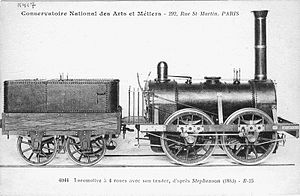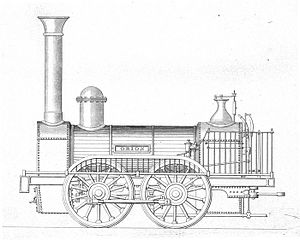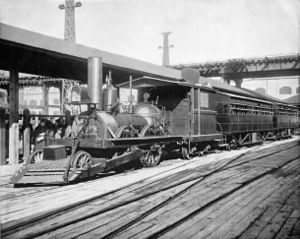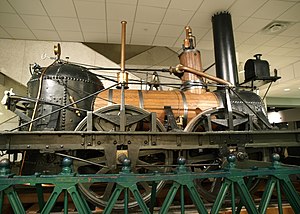User:Colin Douglas Howell/Galleries/Samson and other similar 0-4-0s of the 1830s
Just as the 2-2-0 with inside cylinders became the common configuration for British and European passenger locomotives of the early to middle 1830s, during this same period the 0-4-0 with inside cylinders became the common form for British and European goods engines. Because the 0-4-0 had all its wheels driven, its full weight was available for adhesion, allowing it to have much greater tractive effort than the 2-2-0. This was exactly what was needed to pull heavy goods trains.
Stephenson's Samson-type 0-4-0 locomotives, 1831[edit]
In 1831, Robert Stephenson introduced the Samson, an 0-4-0 development of his Planet. Samson was intended for hauling heavy trains up grades; Stephenson originally called the design the "large Engine for Inclined Plane". It had the same general layout as the Planet type, but it replaced the front carrying wheels and rear drivers with four coupled drivers. This, together with enlarged cylinders and a bigger boiler, gave it the additional tractive effort and power needed to tackle grades with heavy loads. In order to allow the piston and connecting rods to reach the rear crank-axle, the cylinders were slightly inclined so that the piston rod would be clear of the front axle.
Stephenson built only two of these locomotives for the Liverpool and Manchester Railway, Samson and Goliah, but many others were built for other railways. The type was often used as a goods engine. Like the Planet, the Samson design was widely copied and became the most common British and European goods locomotive of the early to middle 1830s. Some examples were exported to the U.S. or built in America, but as with the Planet types, they often had to be modified to work well on twisty American tracks.
-
Model of an unidentified Stephenson 0-4-0 goods engine. Image misdates type to 1883, but this is clearly an 1830s design, perhaps from 1833.
-
An 1840 drawing of Orion, a Samson-type 0-4-0 goods engine from an unidentified railway.
-
The U.S. locomotive John Bull, a Stephenson 0-4-0, in its original form before its 1832 alteration (see below).
Bury bar-framed 0-4-0s, late 1830s[edit]
During the late 1830s Edward Bury made 0-4-0 locomotives with the same bar frames and cylindrical high-domed firebox as on his 2-2-0s. These 0-4-0s were the standard goods engines of the London and Birmingham Railway.
-
Contemporary drawing of a Bury 0-4-0 of the London and Birmingham.
John Bull, 1831[edit]
John Bull, one of the oldest surviving American locomotives, was built in 1831 by Robert Stephenson for New Jersey's Camden and Amboy Railroad, according to the design of the railroad's chief engineer, Robert L. Stevens. Originally, it was built as a Samson-style 0-4-0, but smaller than Samson. It also had a cylindrical domed firebox somewhat like a Bury firebox; this was an unusual design for Stephenson and was included at Stevens' request.
(The locomotive was originally named Stevens; the name "John Bull" started as an informal moniker which caught on.)
Soon after John Bull entered service, an extra non-swiveling single-axle leading truck with a pilot ("cowcatcher") was added. This truck served to guide the locomotive's front end into curves and could pivot vertically to deal with bumps and hollows. It allowed the locomotive to handle twisty American track much more easily, but there was a cost. With the extra truck fitted, the drive wheels' coupling rods could not be used; only the rear crank axle was driven and the former front driving axle became an idle axle, so the locomotive's tractive effort was reduced. (Actually, according to the mechanic who assembled John Bull and performed the conversion work, the coupling rods had already been removed anyway, since the original locomotive had such trouble handling curves; with them removed, the front axle could be given extra side-play.)
The converted John Bull might be said to be a 4-2-0, but it really had a unique layout quite different from the typical 4-2-0. (Some choose to call it a 2-2-2-0 or (2-2)-2-0.)
John Bull also received a number of other improvements, including a spark arrestor, a bell, a headlight, and a tender with a cab overhang. After a career which lasted some thirty years, it was set aside for preservation. Some further alterations were made in the late 19th century to give it a more "antique" look; unfortunately, these turned out to be somewhat inaccurate. Today it resides at the Smithsonian's National Museum of American History. In 1981 it was restored to full running order and operated to mark its 150th anniversary, making it at the time the world's oldest operable locomotive, though it's unlikely that it will ever be run again. A working replica, built in 1939, is at the Railroad Museum of Pennsylvania.
-
John Bull at the 1893 World's Columbian Exposition.
-
John Bull on display at the Smithsonian.
-
The John Bull replica at the Railroad Museum of Pennsylvania. The replica has a spark arrester like that fitted to John Bull early during its service. (More pictures.)







